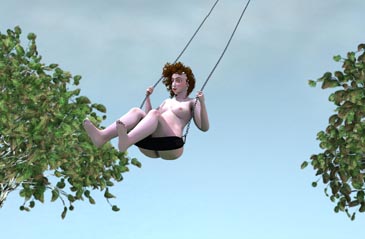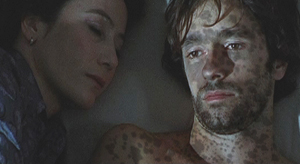
Claudia Hart’s The Swing, one of the featured works in the ongoing exhibition Meme: Romanticism (Photos: EFA)
I have to admit I find the now-popular intellectual act of turning one’s nose up at the overly highbrow while championing mass culture a bottomless pit of good conversation. Three years ago, for example, it would have been hard to sell anyone on the idea that you could find more substance in Internet chain letters and memes than such life-changing intelligence as the kinkiest place you’ve had sex. Web geeks, however, would have told you well before then that the phenomenon held more significance. And while the idea of a meme as information exchange may not sound so radical today with the ubiquity of Internet use joining hacker culture to the mainstream, for this same reason Meme: Romanticism, an exhibition currently on view at the Elizabeth Foundation for the Arts, makes an especially timely appearance; even if you’re not familiar with the practice’s terminology and techniques you’ve probably experienced enough viral media by 2007 to have a basic understanding of the concept.
I know this seems like a bold statement to be issuing in mid-March, but I’ll be surprised if I see a better exhibition this year. Though not all the work in this show is Web-based – some works are purely video, others are photographic stills – the pieces share technological aesthetics that together represent a new school of contemporary filmmakers and artists whose art parallels the age of Romanticism. Similarly defined by a reaction to the trumpeting of reason — often by simply working against the objective and disinterested biases of technology — Meme: Romanticism not only stresses emotion as the source of aesthetic experience, but defines this experience as paradoxically continuous, contagious and fleeting.
Setting the exhibition space up to approximate a lobby and a theatre, independent curator Michele Thursz places Carlo Zanni’s looping video (and the show’s linchpin) The Possible Ties between Success and Illness outside the actual screening room. “It’s not a matter of accepting death — it’s just a word,” the narrator tells us, drawing from the last page of John Haskell’s 2004 novel American Purgatorio. The film pictures a man covered in spots, presumably on his death bed, as the narration continues: “It doesn’t happen like that. ‘Accepting’ is a word in a dictionary, and what happens isn’t a word — just like clouds aren’t words, or the man driving by with his arms out the window isn’t a word. But they happen. They all happen and then they’re gone.”
I suppose only the nerdiest of Internet users read these words and immediately relate them to hit counts or other Web metrics, but Zanni takes this a step further by setting up a program using Google analytics to create more or fewer spots on the ailing man’s body contingent on the amount of visitors to the film’s Web site. Probably my favorite aspect of this piece lies in the premise that a good idea might kill a man, though it speaks on many more levels as well, underscoring and ultimately literalizing the viral nature of Web traffic and the fragility of success.
In contrast to Zanni’s complex narrations, artist Claudia Hart’s The Swing creates a simple three-dimensional animated loop of a chubby nude on a swing suspended from the sky. Generally speaking, I’m not a fan of Second Life-like animation — the overly uniform rendering in the 3-D virtual world built and owned by its users appeals little to my tastes — so my initial inclination was to dismiss the video’s reference to the Baroque painter Peter Paul Rubens as easy and insubstantial. Give the work the 10 minutes it deserves, however, and the grace of the action itself will seduce you: The rhythm of the swing matches the music box score; the movement of the background forest relative to the figure feels oddly surreal; the hypnotic repetition of the loop keeps the work compelling. What’s more, the flow of the video itself elegantly represents art history as self-propelling and continuous.
In addition to these works in the “lobby” area of the exhibition, Meme: Romancism also maintains a theater and regular screening times for six different videos. The lone feature length film of the exhibition, Reynold Reynolds and Patrick Jolley’s disturbing Sugar, details (without dialogue) a young woman’s move into an apartment strewn with the belongings of its previous tenant. In the tradition of movies like Memento and Primer, which either run out of sequence or loop and obscure meaning, this plot point remains unclear for most of the film as it opens with the protagonist entering her apartment via a mini-fridge, apparently mid way through her experience. The viewer eventually concludes that she’s insane, and whether or not she was when she arrived, she certainly becomes so; endless calls from the old tenant’s mother and friends don’t help, nor does the accidental ingestion of cockroach poison.
Unlike Zanni’s work, which, in theory at least, gives the audience some say in the health of the ailing man, Sugar relinquishes no control to its viewers. Those watching the film witness the same harrowing scenes unfold a second time in a nearly identical loop, a technique that not only serves to build discomfort and underscore the inevitability of death and insanity in such a home, but also ties together the threads of the narrative. As such, the film serves to reinforce the idea that Romanticism naturally gravitates to the morose, and that the meme may merely exaggerate this.
And therein lies the essence of the exhibition: The works aren’t just about creating a reaction, but rather about multiplying and building upon the experience. The prospective emotional toll may not be especially appealing, but the imagination that thrives in the cold frontier of technology demands the consideration.
This article was originally published March 12 2007, at The Reeler.



Comments on this entry are closed.